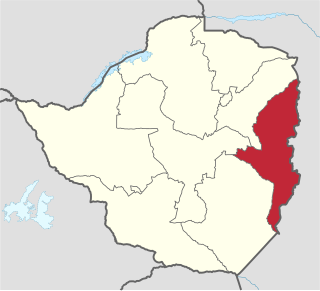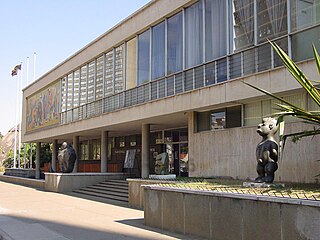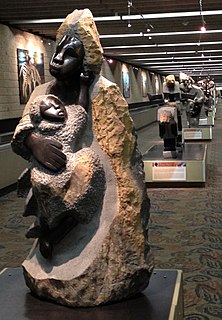Related Research Articles

Harare is the capital and most populous city of Zimbabwe. The city proper has an area of 960.6 km2 (371 mi2) and a population 2,123,132 in the 2012 census and an estimated 3,120,917 in its metropolitan area in 2019. Situated in north-eastern Zimbabwe in the country's Mashonaland region, Harare is a metropolitan province, which also incorporates the municipalities of Chitungwiza and Epworth. The city sits on a plateau at an elevation of 1,483 metres above sea level and its climate falls into the subtropical highland category.

Eltham Palace is a large house at Eltham in southeast London, England, within the Royal Borough of Greenwich. The house consists of the medieval great hall of a former royal residence, to which an Art Deco extension was added in the 1930s. The hammerbeam roof of the great hall is the third-largest of its type in England, and the Art Deco interior of the house has been described as a "masterpiece of modern design". The house is owned by the Crown Estate and managed by English Heritage, which took over responsibility for the great hall in 1984 and the rest of the site in 1995.

Manicaland is a province in eastern Zimbabwe. After Harare Province, it is the country's second-most populous province, with a population of 1.75 million, as of the 2012 census. After Harare and Bulawayo provinces, it is Zimbabwe's third-most densely populated province. Manicaland was one of five original provinces established in Southern Rhodesia in the early colonial period. The province is divided into ten administrative subdivisions of seven rural districts and three towns/councils, including the provincial capital, Mutare. The name Manicaland is derived from the province's largest ethnic group, the Manyika, a Shona subgroup who speak a distinct Shona dialect, Manyika.

Mutare is the most populous city in the province of Manicaland, and the third most populous city in the Zimbabwe, having surpassed Gweru in the 2012 census, with an urban population of 188,243 and approximately 260,567 in the surrounding districts giving the wider metropolitan area a total population of over 500,000 people. Mutare is also the capital of Manicaland province and the largest city in Eastern Zimbabwe.

Abel Tendekayi Muzorewa, also commonly referred to as Bishop Muzorewa, served as Prime Minister of Zimbabwe Rhodesia from the Internal Settlement to the Lancaster House Agreement in 1979. A United Methodist Church bishop and nationalist leader, he held office for only a few months.
Sir Stephen Lewis Courtauld was an English philanthropist associated with geographical exploration, the restoration of Eltham Palace in south-east London, and cultural and education causes, both in the UK and in Southern Rhodesia, where he and his wife also donated to organisations promoting racial equality.
Nyazura is the second largest urban settlement in Makoni District in Manicaland Province, Zimbabwe located 72 km north-west of Mutare on the main road and railway linking Harare and Mutare. The settlement is named after the Nyazure River which is a tributary of the Save River. The phosphate from Dorowa are handled by the railways here. The town is located 191km from Harare along the Harare Mutare Highway. It is 20 kilometres from Rusape and 70km from Mutare. The major part of Nyazura is believed to be under the rule of the Rukweza family
Articles related to Zimbabwe include:

The National Gallery of Zimbabwe (NGZ) is a gallery in Harare, Zimbabwe, dedicated to the presentation and conservation of Zimbabwe's contemporary art and visual heritage. The original National Gallery of Rhodesia was designed and directed by Frank McEwen, a British citizen credited with bringing Shona Sculpture to the spotlight. The Gallery was officially opened by Queen Elizabeth The Queen Mother on 16 July 1957 and Queen Elizabeth II attended the sixth Zimbabwe Heritage Exhibition there in October 1991.

The following outline is provided as an overview of and topical guide to Zimbabwe:

Sculpture and in particular stone sculpture is an art for which Zimbabwe is well known around the world.
Nedbank Zimbabwe Limited, also Nedbank Zimbabwe, is a commercial bank in Zimbabwe. It is licensed by the Reserve Bank of Zimbabwe, the central bank and national banking regulator. The bank was previously known as MBCA Bank, prior to rebranding to its present name.
Mah-Jongg or Jongy was a ring-tailed lemur owned by Virginia and Stephen Courtauld, wealthy English philanthropists from a family of textile manufacturers. Lemurs are large primages endemic Madagascar. Mahjong is a tile-based game developed in China.
The Church of Jesus Christ of Latter-day Saints in Zimbabwe reported 32,937 members in 7 stakes, 3 district, and 80 congregations, as of 31 December 2018.
The following is a timeline of the history of the city of Harare, Zimbabwe.
Prag Lalloo Naran was a Zimbabwean politician and businessman recognized as a "Nationalist for the struggle for Zimbabwe’s independence," and a "leading member of the (Zimbabwe) Asian Community".

Beira-Bulawayo railway, also called Machipanda railway, Beira-Harare-Bulawayo railway and Beira railway, is a railway that connects the city of Beira, Mozambique, to the city of Bulawayo, in Zimbabwe. It is 850 km long, in a 1067 mm gauge.
Michael Theodore Hayes Auret was a Zimbabwean farmer, politician, and activist. A devout Catholic, he served as chairman and later director of the Catholic Commission for Justice and Peace in Zimbabwe (CCJP) from 1978 until 1999. He also served as a member of Parliament for Harare Central from 2000 to 2003, when he resigned and emigrated to Ireland.
Zimbabwe Newspapers (1980) Limited, operating as Zimpapers, is a state-controlled Zimbabwean mass media company. Originally a newspaper Publishing company, in the 2010s it expanded its operations to include commercial printing, radio and television. The company's portfolio includes over a dozen Magazines and newspapers, including The Herald and The Chronicle, several radio stations, and a television network. It is the largest newspaper publisher in Zimbabwe.

Highlands is a middle class, residential suburb in the east of Harare, best known as the home of the Zimbabwe Broadcasting Corporation, and for its ethnic diversity, history, natural environment and splendid panoramic views of downtown Harare. It is often grouped in the inner east suburbs of Harare such as Eastlea, Highlands, Greendale and Milton Park.
References
- ↑ "La Rochelle Estate – National Trust of Zimbabwe". ntoz.org.
- ↑ British Library 'Oral history of the Courtaulds at Eltham Palace' Bernard, Margaret
- ↑ "Welcome - La Rochelle Country House - Penhalonga, Zimbabwe". larochellecentre.com.
- ↑ "National Gallery of Zimbabwe historical background". www.nationalgallery.co.zw.
- ↑ Richard Hughes "Capricorn: David Stirling's African Campaign" p.101
- ↑ "La Rochelle Country House". INTO Farms. 11 March 2018.